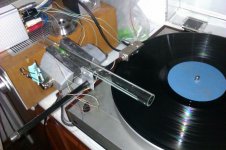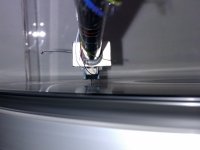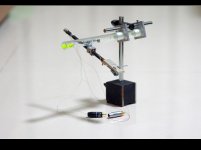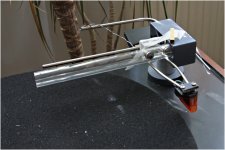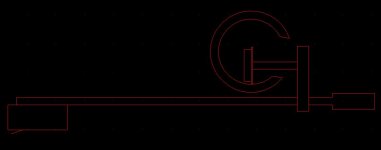I had the pleasure of hearing the Clear Audio linear tracking tone arm yesterday.
Its a substantial piece of equipment and compared to the Opus, some might say over engineered. It is solid and heavy. The entire arm lifts up vertically and locks in place for record removal.
I got a good glimpse at the bearings. They are tiny and have a rounded surface, fitting perfectly inside the glass tube. They were smaller than I imagined. The arm tube is thin and short and carbon fiber.
Its a substantial piece of equipment and compared to the Opus, some might say over engineered. It is solid and heavy. The entire arm lifts up vertically and locks in place for record removal.
I got a good glimpse at the bearings. They are tiny and have a rounded surface, fitting perfectly inside the glass tube. They were smaller than I imagined. The arm tube is thin and short and carbon fiber.
eaglebear,
You've produced a very interesting arm. I like its simplicity and industrial/lab appearance. I have a bunch of questions.
It looks like you've used an unconventional arrangement for the vertical movement. Is the arm stable when playing warped LPs? Did you stick with that arrangement or go back to the original?
How much does the arm, headshell, cartridge, etc weigh? What cartridge is in it and what VTF is it set at? Does the stylus stay centered? Any skips or mistracking?
Is the arm mounted on a TT and how does it sound?
I know, lots of nosy questions, but I really am interested and I'm probably not the only one.
You've produced a very interesting arm. I like its simplicity and industrial/lab appearance. I have a bunch of questions.
It looks like you've used an unconventional arrangement for the vertical movement. Is the arm stable when playing warped LPs? Did you stick with that arrangement or go back to the original?
How much does the arm, headshell, cartridge, etc weigh? What cartridge is in it and what VTF is it set at? Does the stylus stay centered? Any skips or mistracking?
Is the arm mounted on a TT and how does it sound?
I know, lots of nosy questions, but I really am interested and I'm probably not the only one.
dtut,
I place this arm on the table , left side of TT without any glue on base because the base is heavy enough to keep its steadiness.
I adjust the the tube position to keep stylus in linear tracking and right VTA(about 20 degree) firstly,and then stick two square card on table to limit the position.
I didn't weigh the total sub-arm,only weigh the stylus pressure is 1.6g for EXCEL ES-70S.The stylus basically stay in the centre of sound track by my visual observation,it can smoothly move form the beginning to end if the record in good condition(without deep scratch).
I‘ve fixed an arm lift on this tonearm,and will upload a playing video lately.
The 2 key points for DIYing this kind tonearm is:
1、the inner surface flatness and cleanness of glass tube;
2、the smoothly of small bearing,you need high quality bearing.(My choice is SKF MR83)
I place this arm on the table , left side of TT without any glue on base because the base is heavy enough to keep its steadiness.
I adjust the the tube position to keep stylus in linear tracking and right VTA(about 20 degree) firstly,and then stick two square card on table to limit the position.
I didn't weigh the total sub-arm,only weigh the stylus pressure is 1.6g for EXCEL ES-70S.The stylus basically stay in the centre of sound track by my visual observation,it can smoothly move form the beginning to end if the record in good condition(without deep scratch).
I‘ve fixed an arm lift on this tonearm,and will upload a playing video lately.
The 2 key points for DIYing this kind tonearm is:
1、the inner surface flatness and cleanness of glass tube;
2、the smoothly of small bearing,you need high quality bearing.(My choice is SKF MR83)
I got a good glimpse at the bearings. They are tiny and have a rounded surface, fitting perfectly inside the glass tube. They were smaller than I imagined. The arm tube is thin and short and carbon fiber.
Some pictures on the net.
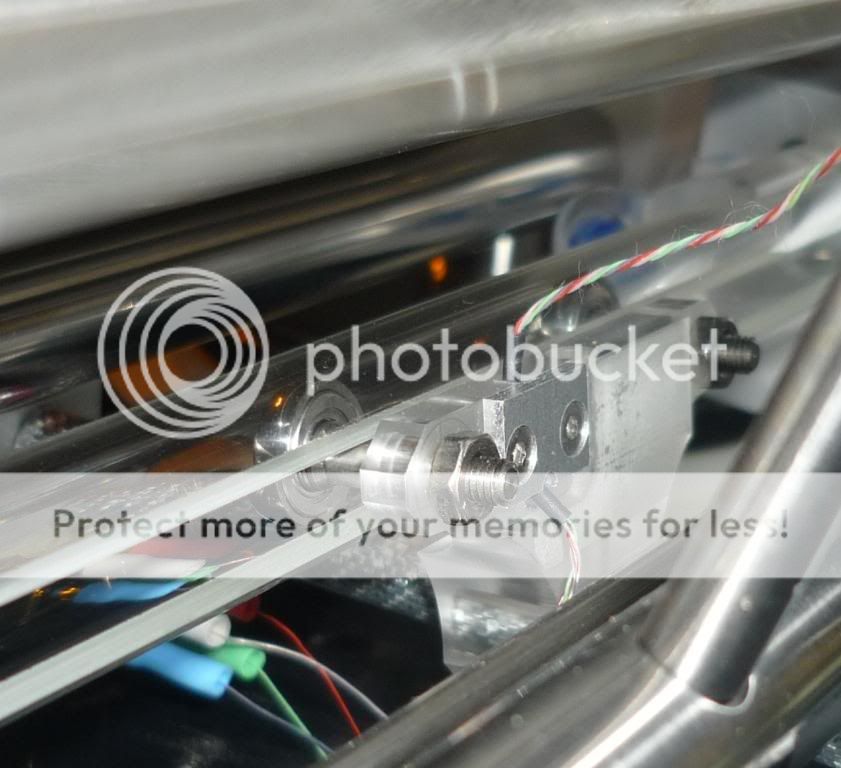
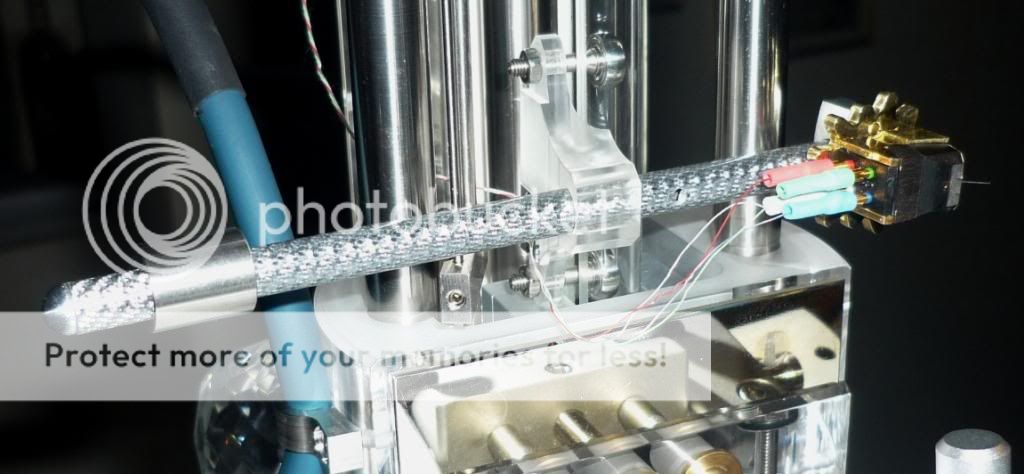
arrangement:
sample video:
Glass tube linear tracking tonearm | Flickr - Photo Sharing!
An externally hosted image should be here but it was not working when we last tested it.
sample video:
Glass tube linear tracking tonearm | Flickr - Photo Sharing!
arrangement:
An externally hosted image should be here but it was not working when we last tested it.
sample video:
Glass tube linear tracking tonearm | Flickr - Photo Sharing!
Please try another address if can't play form flickr:
http://player.56.com/v_Njk1NTA4NDM.swf
my glass tube tonearm
View attachment 287782
eaglebear,
Great experiment, and thanks for the video of it in action. What have you used for the vertical pivot bearings? I have been thinking about building a lt arm with vertical pivot bearings and have put together a crude test unit. So crude it has lots of problems and promise. The most important feature is the ability to set and measure VTF. I find it very difficult to do in the original CANTUS design.
Going back to the early postings on the Cantus arm and the discussion of forward and back motion, not up and down, and the quote from Bo Hansson of his goal in doing the design, I find no reason that that a vertical motion provided by bearings, pivots etc such as you have done does not meet Bo's requirements. In fact I'm beginning to believe that the arguments supporting Bo's design are largely words not facts. The design where vertical tracking is implemented by the radial play in the ball bearings unquestionably works and works well. It is not without problems though, and achieving the desired VTF is IMHO the main one.
So, eaglebear, thanks for your work so far. I will continue to explore your desgn concepts. LT is the way to go.
bgruhn
Last edited:
It looks like eaglebear has added a valuable new wrinkle to LT design just when I thought most of the basic elements were pretty much established. I considered a vertical pivot using a string bearing, but thought it would involve a tricycle carrier and was reluctant to add the weight and friction of a third bearing. I didn't think eaglebear's design would be stable, but it does seem to be.
Another reinforced lesson about tinkering - check it out even if it turns out wrong.
BillG - good to see you posting again. A couple of thoughts - it might be that a very shallow V would work well coupled with vertical bearings. And I built a pivot arm with CD player bushings handling the vertical. They're very good bearings, light and precise. Something like that might do for the eagelbear arrangement
Congratulations eaglebear on your interesting and successful LT. I hope you are enjoying listening to it.
Another reinforced lesson about tinkering - check it out even if it turns out wrong.
BillG - good to see you posting again. A couple of thoughts - it might be that a very shallow V would work well coupled with vertical bearings. And I built a pivot arm with CD player bushings handling the vertical. They're very good bearings, light and precise. Something like that might do for the eagelbear arrangement
Congratulations eaglebear on your interesting and successful LT. I hope you are enjoying listening to it.
vertical pivot...
If you look at Bo's early design he did in fact have a vertical motion component. Bo used what I would call a rolling knife edge bearing which allowed the arm to pivot back and forth like an SME3009. This aspect of the design was later dropped for the current two bearing four point contact design. I discussed this with Bo as I had been considering a rolling knife edge design myself. Bo convinced me this was not the way to go. Bo had a lot of hands on experience with the design and his later version is from accounts superior to the earlier version. Best regards Moray James.
If you look at Bo's early design he did in fact have a vertical motion component. Bo used what I would call a rolling knife edge bearing which allowed the arm to pivot back and forth like an SME3009. This aspect of the design was later dropped for the current two bearing four point contact design. I discussed this with Bo as I had been considering a rolling knife edge design myself. Bo convinced me this was not the way to go. Bo had a lot of hands on experience with the design and his later version is from accounts superior to the earlier version. Best regards Moray James.
eaglebear,
Great experiment, and thanks for the video of it in action. What have you used for the vertical pivot bearings? I have been thinking about building a lt arm with vertical pivot bearings and have put together a crude test unit. So crude it has lots of problems and promise. The most important feature is the ability to set and measure VTF. I find it very difficult to do in the original CANTUS design.
Going back to the early postings on the Cantus arm and the discussion of forward and back motion, not up and down, and the quote from Bo Hansson of his goal in doing the design, I find no reason that that a vertical motion provided by bearings, pivots etc such as you have done does not meet Bo's requirements. In fact I'm beginning to believe that the arguments supporting Bo's design are largely words not facts. The design where vertical tracking is implemented by the radial play in the ball bearings unquestionably works and works well. It is not without problems though, and achieving the desired VTF is IMHO the main one.
So, eaglebear, thanks for your work so far. I will continue to explore your desgn concepts. LT is the way to go.
bgruhn
yes!I fixed two micro bearings(size:1*3*1) in arm bracket for arm vertical pivot, this point is different from Opus.
If you look at Bo's early design he did in fact have a vertical motion component. Bo used what I would call a rolling knife edge bearing which allowed the arm to pivot back and forth like an SME3009. This aspect of the design was later dropped for the current two bearing four point contact design. I discussed this with Bo as I had been considering a rolling knife edge design myself. Bo convinced me this was not the way to go. Bo had a lot of hands on experience with the design and his later version is from accounts superior to the earlier version. Best regards Moray James.
Here is a drawing of Bo's original bearing assembly as you can see this is essentially a "rolling knife edge" bearing. Clear audio have copied this style of bearing though they executed it in a different way it is the same thing. Bo was adamant that the more motion the arm allowed the poorer the arm will sound. I think Bo is right. Best regards Moray James.
Attachments
Last edited:
Here is a drawing of Bo's original bearing assembly as you can see this is essentially a "rolling knife edge" bearing. Clear audio have copied this style of bearing though they executed it in a different way it is the same thing. Bo was adamant that the more motion the arm allowed the poorer the arm will sound. I think Bo is right. Best regards Moray James.
Thanks Moray,
This post is a bit of further thinking on the topic and a test of Touch-freeze to see if this automatic touch pad dis-abler I just installed to try to clean up a touch pad/keyboard problem I'm having with this lap top works. So far it seem to be great! Right now I'm so tied up with landscaping and other house chores that I can't build the carriage I have in mind, but it is not unlike what eaglebear has done. There is a basic difference between what Bo has with the flanged bearing outer race and the wider outer race he subsequently used. All the rest of us have used the wider bearing and its 4 point contact. The thin flange is very close to being a rolling knife edge with good vertical motion possible over a wide range of vertical motion. It also is not held rigidly relative to position forward and backward on the inner surface of the glass tube track. I feel that the more rigid positioning provided by the wider 4 point contact bearing race is key to the great audio performance of the Cantus. But unlike the pseudo rolling knife edge the range of vertical motion provided by the ball bearing's radial play is just too small to deal with more than ordinary small warps of the LP. Also the freedom of vertical motion provided by by a vertical bearing system such as eaglebear has used will allow setting and maintaining correct VTF. Vertical motion provided by the Ladegaard pivot should do it too. The rigidity of the 4 point bearings on the horizontal track is maintained as well. I'm looking forward eagerly to testing this theory with a redesigned carriage. Sorry for the long post. BTW (ot) Touch-freeze has worked perfectly through this entire posting.
Rgds,
BillG
Bill: when I first asked Bo about warped records he told me that if a record was so warped that I could not play it on a Cantus I should get a better copy as it was not worth playing anyway. I think that Bo is right. The Cantus will track a warp and it will even drag the carriage up the inside wall of the glass tube to do so. Just because you can track a warp does not mean you would want to listen to it or to have the ware and tear on your cartridge. The rolling knife edge will let you play a more severe warp than will the present Cantus system and I expect that was why Clear Audio chose to use the rolling knife edge system so their customers can play any old record after all they did pay all that money for the system but for some reason they cannot afford to replace badly warped records. From all I can find out from Cantus owners they seem to be pleased with the new Cantus and how it will ride a warp.
I do look forward to reading the results of your experiments with a vertical pivot for the arm. This was initially a concern for me but i am not worried about it now. One thing that I have noticed is the lack of used Cantus for sale on the open market. I have not seen any for sale old or new that I can think of so owners must be satisfied. Please post some pictures or drawings if you can so we can see what you plan to try out. Best regards Moray James.
Remember that Bo was the original importer of Lou Souther's arm and that had a vertical pivot and would ride warps that were mind bending. I had Lou give me a personal demonstration which was nothing short of amazing, a record playing tour de force of vertical warps and horizontal offset the likes I had never seen nor thought possible.
Bo wanted to improve upon the Souther and so the Cantus was born. Designs are all about compromises and there are always other ways to do a task. I do look forward to your results as you may just have a winner on your hands.
I do look forward to reading the results of your experiments with a vertical pivot for the arm. This was initially a concern for me but i am not worried about it now. One thing that I have noticed is the lack of used Cantus for sale on the open market. I have not seen any for sale old or new that I can think of so owners must be satisfied. Please post some pictures or drawings if you can so we can see what you plan to try out. Best regards Moray James.
Remember that Bo was the original importer of Lou Souther's arm and that had a vertical pivot and would ride warps that were mind bending. I had Lou give me a personal demonstration which was nothing short of amazing, a record playing tour de force of vertical warps and horizontal offset the likes I had never seen nor thought possible.
Bo wanted to improve upon the Souther and so the Cantus was born. Designs are all about compromises and there are always other ways to do a task. I do look forward to your results as you may just have a winner on your hands.
- Status
- This old topic is closed. If you want to reopen this topic, contact a moderator using the "Report Post" button.
- Home
- Source & Line
- Analogue Source
- Opus 3 Cantus parallel tracking arm
